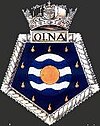 RFA Olna underway in 1991
| |
| History | |
|---|---|
| Name | RFA Olna |
| Ordered | 4 February 1963 as AO 16 |
| Builder | Hawthorn Leslie and Company |
| Yard number | 756 |
| Laid down | 2 July 1964 |
| Launched | 28 July 1965 by Barbara Redman |
| In service | 1 April 1966 |
| Out of service | 24 September 2000 |
| Identification |
|
| Honours and awards |
|
| Fate |
|
| Notes | [1][2] |
| Badge |  |
| General characteristics | |
| Class and type | Ol-class tanker |
| Tonnage | |
| Displacement | 36,605 long tons (37,192 t) full load |
| Length | 648 ft (198 m) |
| Beam | 84 ft 2 in (25.65 m) |
| Draught | 34 ft (10 m) |
| Depth | 44 ft (13 m) |
| Installed power |
|
| Propulsion | |
| Speed | 21 knots (24 mph; 39 km/h) |
| Range | 10,000 nmi (19,000 km) at 16 kn (18 mph; 30 km/h) |
| Complement |
|
| Armament |
|
| Aircraft carried | 3× Westland Wessex or Westland Sea King helicopters |
| Aviation facilities | Helicopter deck, hangar |
| Notes | [3] |
| Service record | |
| Operations: |
|
RFA Olna (A123) was the third and final of the three Ol-class "fast fleet tanker" of the Royal Fleet Auxiliary (RFA), the naval auxiliary fleet of the United Kingdom. When she entered service she was one of the largest and fastest ships in the RFA Fleet. Olna saw service in the Falklands War and the Gulf War.
Her design was a development of the later Tide-class ships of the early 1960s. She was entered service in 1966 and served in the Royal Fleet Auxiliary for 34 years. Olna was the third ship to bear the name.
- ^ "RFA Olna - Historical RFA". historicalrfa.uk. 26 October 2008. Retrieved 6 August 2024.
- ^ "RFA Olna A123". helis.com. Retrieved 6 August 2024.
- ^ Puddefoot 2009, p. 196.